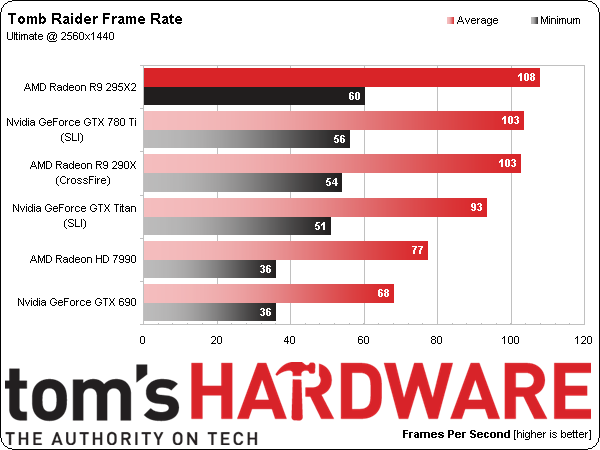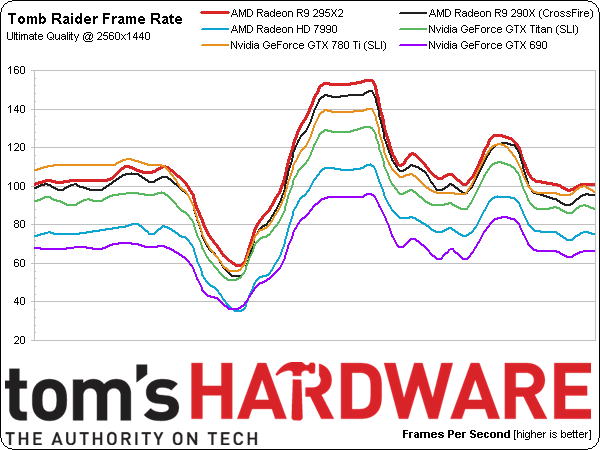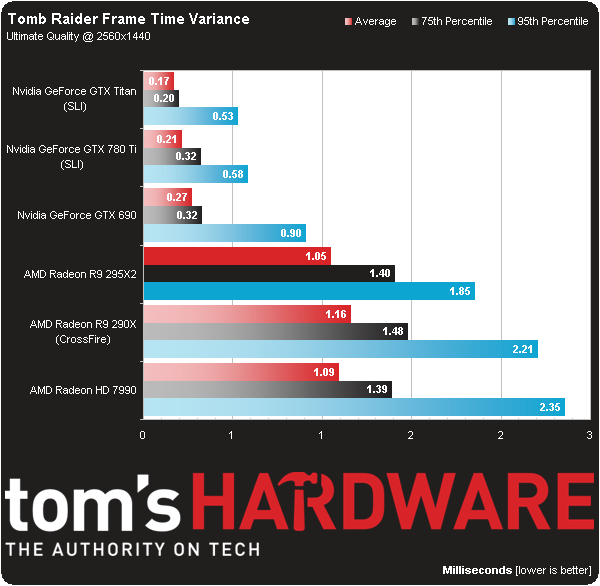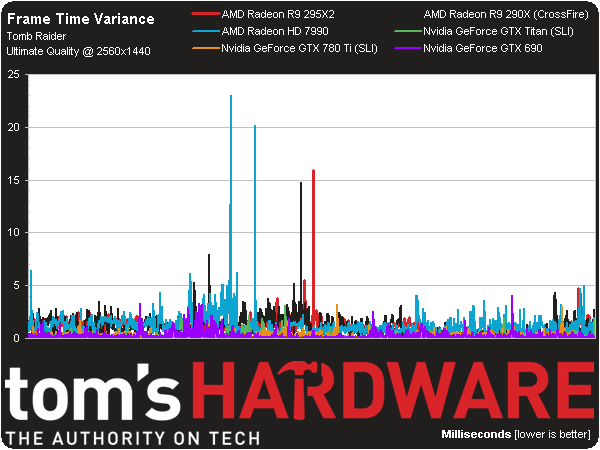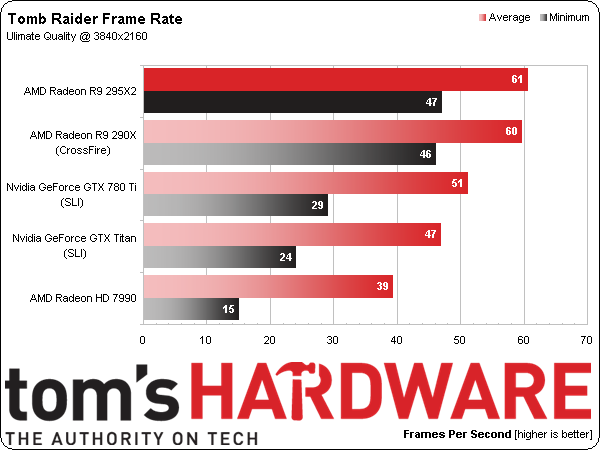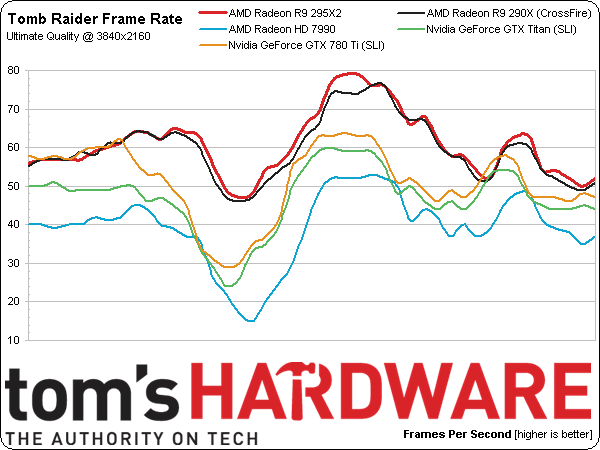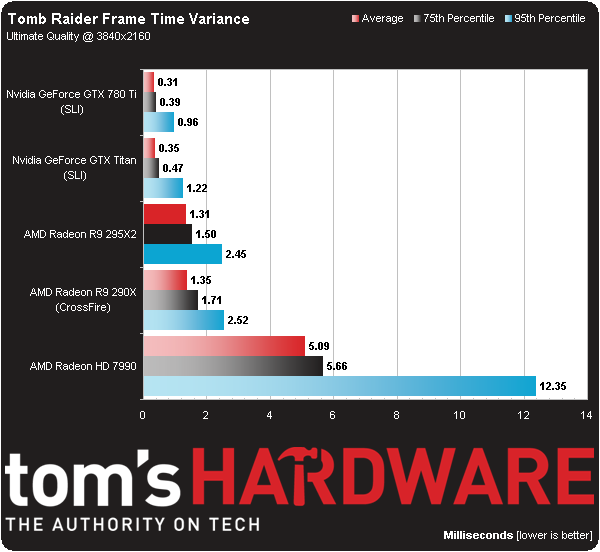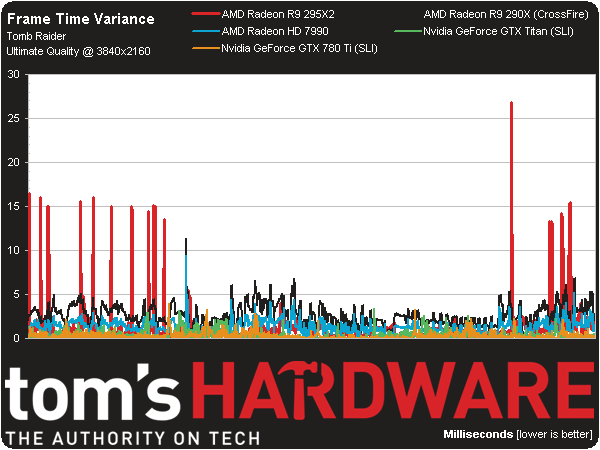Radeon R9 295X2 8 GB Review: Project Hydra Gets Liquid Cooling
“Do you have what it takes?” AMD asks, purportedly referring to the big budget and beefy power supply you need before buying its new Radeon R9 295X2. We benchmark the 500 W, dual-GPU beast against several other high-end configs before declaring a winner.
Results: Tomb Raider
2560x1440
AMD’s new dual-GPU juggernaut takes a first-place finish in Tomb Raider, followed not far behind by GeForce GTX 780 Tis in SLI, Radeon R9 290Xes in CrossFire, and twin Titans.
There’s one particularly demanding sequence in our benchmark that pushes every solution hard. It’s responsible for knocking the Radeon HD 7990 and GeForce GTX 690 down under 40 FPS.
However, Nvidia’s cards are at a notable disadvantage in that they don’t handle the Ultimate preset’s TressFX feature properly. Rather than flowing naturally, Lara’s hair shimmers and pops.
Although this is an AMD Gaming Evolved title, the Radeons demonstrate higher frame time variance than Nvidia’s cards. The results aren’t bad, but you can clearly see in the frame time chart there are a few spikes and overall-higher averages.
3840x2160
More so than Thief, Tomb Raider gobbles up memory. The GeForce GTX 690 crashes before our benchmark finishes, in fact. A pair of Hawaii GPUs, each with 4 GB of fast GDDR5, handle this game best. Even if the Nvidia boards were able to deliver comparable frame rates, they’re still not able to render the TressFX effect correctly.
The Radeon R9 295X2 and two 290Xes in CrossFire perform almost identically. Frame rate over time also shows us how hard Nvidia’s cards get hit when the compute-intensive TressFX technology is featured prominently in the benchmark scene (those big dips correspond to up-close views of Lara’s hair).
The longest bars come from AMD’s Radeon HD 7990, which isn’t playable at 4K using Tomb Raider’s Ultimate quality preset anyway.
Get Tom's Hardware's best news and in-depth reviews, straight to your inbox.
Current page: Results: Tomb Raider
Prev Page Results: Thief Next Page Power Consumption: Introducing Our Equipment-
Marsian Gustrianda Many people doubt about Dual GPU Hawaii will be Blow Up. It seems AMD really do well job. Nice Looking CardReply -
ohim This card is like the Veyron of WV , show the world what you can do (R295x2) but you`ll still relay on the sales of your WV Golf for revenue (270x, 280x)Reply -
outlw6669 Impressive performance, temperatures and fairly low noise!Reply
I would prefer a bit lower price, but this looks like a great card for the gamer that has everything! -
gunfighter zeck the name Dreadnaught originated from Dread Nothing or, fear nothing.Reply
Boss ship. -
Maxamus456 Hope this price stays low and not get bloated from bit con miners like its predecessors.Reply -
blubbey So let me get this straight. It runs pretty cool, quiet, performs well and (for the moment) is able to play a good selection of games at 4k admirably and is priced competitively. Plus if you are going to drop a bit more on watercooling your GPUs (which is a possibility if you're spending $1200+) that gives this card even greater value. Nice work AMD.Reply -
marciocattini Wheres Tom's Hardware seal of approval? =( clearly this card diserves some love!Reply
